Invented by Yunlong GUO, Qiangqiang YAN, Bin Chen, Hongyu Chen, David Malotky, Zhihua Liu, Yan Zhou, Xiucuo Li, Wenjie Chen, Li Ding
Polyorganosiloxane is a type of silicone polymer that is widely used in the production of coatings, adhesives, and sealants. It is known for its excellent thermal stability, chemical resistance, and low surface energy. However, the traditional process of preparing polyorganosiloxane involves the use of solvents, which can be hazardous to the environment and human health.
To address this issue, a solventless process has been developed to prepare polyorganosiloxane pellets. This process involves the use of a twin-screw extruder to mix and melt the silicone raw materials, followed by pelletizing the molten mixture using a pelletizer. The resulting polyorganosiloxane pellets are free from solvents and have a uniform size and shape, making them easy to handle and transport.
The market for solventless polyorganosiloxane pellets is expected to grow in the coming years due to the increasing demand for eco-friendly and sustainable products. The automotive industry, in particular, is a major consumer of polyorganosiloxane pellets, as they are used in the production of high-performance coatings and sealants for cars.
In addition to solventless polyorganosiloxane pellets, there is also a growing market for waterborne solutions of silicone. Waterborne silicone solutions are made by dispersing silicone polymers in water, which eliminates the need for solvents. These solutions are used in a wide range of applications, including coatings, adhesives, and personal care products.
The market for waterborne silicone solutions is expected to grow due to the increasing demand for eco-friendly and low-VOC (volatile organic compound) products. The construction industry, in particular, is a major consumer of waterborne silicone solutions, as they are used in the production of waterproofing and weatherproofing coatings for buildings.
In conclusion, the market for solventless polyorganosiloxane pellets and waterborne solutions of silicone is growing due to the increasing demand for eco-friendly and sustainable products. These products offer excellent performance and are widely used in various industries such as automotive, construction, electronics, and healthcare. As the demand for eco-friendly products continues to grow, the market for solventless polyorganosiloxane pellets and waterborne silicone solutions is expected to expand further in the coming years.
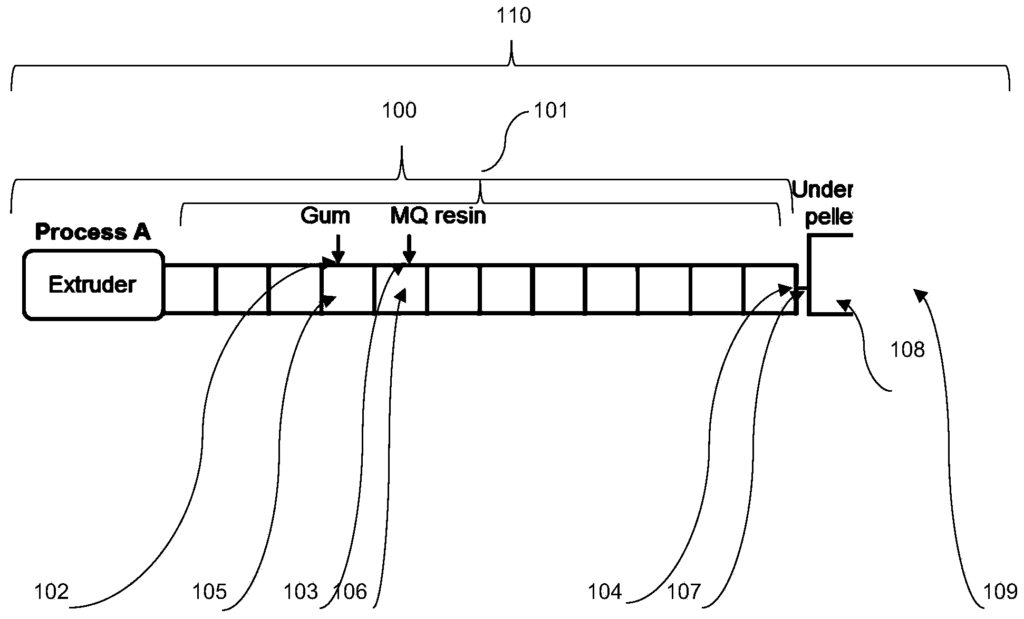
The Yunlong GUO, Qiangqiang YAN, Bin Chen, Hongyu Chen, David Malotky, Zhihua Liu, Yan Zhou, Xiucuo Li, Wenjie Chen, Li Ding invention works as follows
A solventless polyorganosiloxane powder containing a mixture of a polyorganosilicate and a gum is used to prepare a waterborne dispersion for a silicone pressure sensitive adhesive. A free radical initiator can be used to combine the waterborne dispersion with silicone pressure sensitive adhesive base. The silicone pressure sensitive adhesive can then be dried and cured.
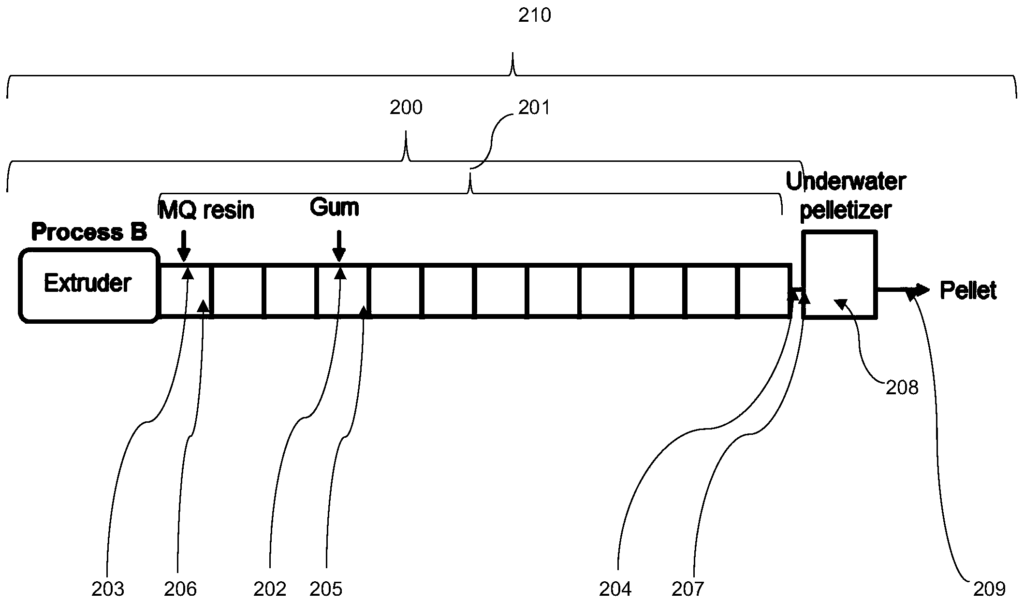
Background for Process to prepare a solventless polyorganosiloxane (polyorganosiloxane) pellet and a waterborne solution of a silicone pressure sensitive adhesive basis
The solventless polyorganosiloxane (Pellet), prepared in the above process comprises a Polydiorganosiloxanc Gum (Gum) as well as a Polyorganosilicatc Resin (Rcsin). The Pcllct could also consist of Gum or Resin. The Pellet could also contain Gum or Resin. The Pellet may contain enough Gum and Resin to give a Resin-to-Gum ratio (R:G ratio) of 2.1 to 3.5?1. Alternately, the R.G ratio could be 2.1 to 4.5 or 3.0 to 4.0 or 2.1 to 3.5?1, 3.0 to 4.0 to 4.0 to 4.1?1, 2.1 to 3.5 to 2.1 to 3.5 to 1, 2.4 to 3.0 to 4.0 to 4.0 to 1.1, 2.2 to 2.9 to 1.1, 2.4 to 3.0 to 3.0 to 4.0 to 1.1, 2.3 to 2.9 to 1 and 2.7 to 2.9 to 1.1, or 2.4 to 2.7 to 2.9 to 2.4 to 2.9 to 2.4 to 2.9 to?1?1?1?1?1 through to 2.5 to 2?1?1?1?1?1?1?1?1?1?1?1?1?1?1?1?1, or alternatively
Gum
The Gum in the Pellet could be a polydiorganosiloxane Gum with an aliphatically unsaturated group or a hydrol group. Average molecular weight (Mn), of Gum is? 150,000 g/mol. Alternatively, 200,000 g/mol up to 1,000,000,000,000 g/mol. Alternately, 300,000 to 800,000g/mol and alternatively, 500,000 g/mol up to 1,000,000g/mol as measured by GPC using the reference example 1 of U.S. Pat. 9,593,209, beginning at col. 31.
The Gum may have a unit formula (G-1), a (R 3R2 2SiO 1/2 a (R2 2SiO 2/2 b (R2SiO 3/2 c), where each R 2 is selected independently from the group consisting an alkyl group with 1 to 18 carbonatoms and an anaryl group with 6 to 18 carbonatoms and each R3 is an independently selected cureable group, subscripted a? 2, subscript: b? 1500 and subscript C? 0, subject to the condition that the Gum will be supplied with sufficient quantities (a+ b+c). Subscript a can also be 2. Subscript b can be anywhere from 2500 to 8000; 4000 to 6600; 5300 to 6600; or 5400 to 5900. Subscript c could also be 0.
R 2 can be an alkyl group with 1 to 18 carbonatoms in unit formula (G-1). Alternately, each R 2 could have 1-12 carbon atoms or 1-6 carbon atoms. ?Alkyl? Alkyl is a saturated monovalent, cyclic, or branched hydrocarbon group. Examples of alkyl include methyl, epi, propyl (e.g. isopropyl and/or nu-propyl), butyls (e.g. isobutyl or n-butyl), butyl (e.g. isopentyl/neopentyl/tert-pentyl), pentyl (e.g. isopentyl/tert-pentyl), hexylsyl group, cyclopentyl-hexyl and cyclohexyl One or more instances R 2 could also be an aryl group. ?Aryl? Aryl is a fully unsaturated cyclic hydrocarbon group. Examples of Aryl include phenyls, cyclopentadienyls, anthracenyls, and naphthyl. Monocyclic aryl group may contain 5 to 9 carbonatoms. Alternately, 6 to 7 carbonatoms and alternately, 5 to 6 carbonatoms. Polycyclic aryl group may contain 10 to 17 carbonatoms. Alternately, 10 to 14 carbonatoms and 12 to 14 carbonatoms. Alternately, each R 2 could be selected independently from methyl or phenyl. Alternately, each R2 could be alkyl. Alternately, each R 2 could be methyl.
Each R 3 in unit formula (G-1) is a cureable group. Each R 3 can be selected independently from the group consisting OH and a monovalent, al iphatically unsaturated hydrocarbon group with 2 to 18 carbonatoms. Alternately, R 3’s aliphatically unsaturated hydrocarbon group may contain 2-12 carbon atoms or 2-6 carbon atoms. Alkenyl and alkyl groups are suitable monovalent aliphatically unsaturated hydrocarbon group. Alkenyl is a monovalent hydrocarbon that has one or more carbon-carbon double bond. You can have alkenyl groups that are linear, branched, or cyclic. Vinyl, allyl and propenyl are examples of suitable alkenyl group (e.g. isopropenyl and/or n?propenyl); and butenyl and pentenyl and hexenyl (also including branched atoms of 4-7 carbon atoms) and cyclohexenyl. Alkynyl is a monovalent hydrocarbon that has one or more carbon-carbon triple bonds. You can have alkyl groups that are branched or unbranched. Ethynyl and propynyl are examples of suitable alkyl groups. Alternately, an aliphatically unsaturated group for R3 could be alkenyl such as vinyl or allyl.
Alternatively, each R2 may be an alkyl, and each R3 may be selected independently from the group consisting OH and an Alkenyl group comprising 2 to 18 carbonatoms. Subscript a could be 2, subscript.c may be 0, and b may range from 5300 to 6600. Alternately, each R 2 could be methyl. Each R 3 may be selected independently from the group consisting OH, vinyl and allyl. Subscript a can be 2, subscript. c may 0 and subscript. b may range from 5400 to 5900.
Alternatively, the Gum may be a bis-hydroxyl-terminated polydiorganosiloxane. The unit formula of the hydroxyl-functional Polydiorganosiloxane could be (G-2): [R2 2 (HO) SiO1/2] 2 (R2 2SiO 2/2/2] d. Each R 2 is described above. Subscript d. Subscript d must have a value that is sufficient to give Gum the Mn mentioned above. Alternatively, the Gum may be a bis-alkenyl-terminated polydiorganosiloxane. The bis-alkenyl-terminated polydiorganosiloxane may have unit formula (G-3) : (R 2 2R 3?SiO 1/2) 2 (R 2 2SiO 2/2) d, where each R 2 is as described above; R 3? Subscript d is an alkcnyl-terminated polydiorganosiloxane as described above. Subscript d must have a value that is sufficient to give Gum the Mn mentioned above. Alternatively, the Gum may be a combination of a bis-hydroxyl-terminated polydiorganosiloxane and a bis-alkenyl-terminated polydiorganosiloxane.
Gums are known in the art and may be prepared by methods such as hydrolysis and condensation of the corresponding organohalosilanes or equilibration of cyclic polydiorganosiloxanes. For example, SILASTICTM SGM-36 can be purchased from Dow Silicones Corporation in Midland, Michigan, USA. Examples of suitable Gums for use herein are exemplified by: i) dimethylvinylsiloxy-terminated polydimethylsiloxane, ii) dimethylvinylsiloxy-terminated poly (dimethylsiloxane/methylphenyl) siloxane, iii) dimethylvinylsiloxy-terminated poly (dimethylsiloxane/diphenyl) siloxane, iv) phenyl, methyl, vinyl-siloxy-terminated polydimethylsiloxane, v) dimethylhexenylsiloxy-terminated polydimethylsiloxane, vi) dimethylhexenyl-siloxy terminated poly (dimethylsiloxane/methylphenyl) siloxane, vii) dimethylhexenylsiloxy-terminated poly (dimethylsiloxanc/diphenyl) siloxane, viii) hydroxyl-terminated polydimethylsiloxane, ix) hydroxyl-terminated poly (dimethylsiloxane/methylphenyl) siloxane, x) hydroxyl-terminated poly (dimethylsiloxane/diphenyl) siloxane, xi) a combination of two or more of i) to x) . Alternatively, the Gum may be selected from the group consisting of i) dimethylvinylsiloxy-terminated polydimethylsiloxane, v) dimethylhexenylsiloxy-terminated polydimethylsiloxane, and a combination i) and v) . The gum can also be chosen from the group consisting viii), ix), and x). You can also choose the gum from the group consisting i) or viii).
Polyorganosilicate Resin
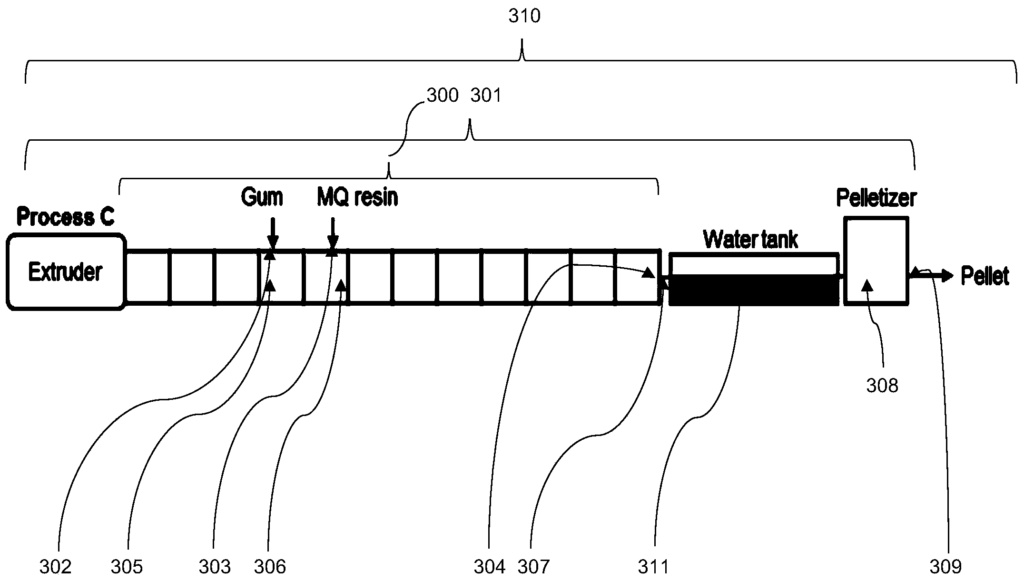
The polyorganosilicate (Resin), comprises monofunctional units (R M 3Sio 1/2) and tetrafunctional (?Q?). Units) of formula SiO4/2, in which each R M is a monovalent hydrocarbon group. R M can have one to twenty carbon atoms. Alternately, R M can be chosen from any of the following groups: alkyl, alkenyl, or aryl. R 2’s alkyl and aryl groupings are the same as R 3’s, while R 3’s alkenyl groupings are the same as R 3. Alternately, each R M in the Resin may be selected independently from the group consisting alkyl, alkenyl and aryl. Alternately, each RM may be chosen from methyl, vinyl, and phenyl. Alternately, at least one third, or alternatively at most two thirds, of the R M group are methyl groups. The monofunctional units can also be represented by (Me 3SiO 1/2), (Me2PhSiO1/2) and (Me2ViSiO1/2). The Resin is soluble in solvents such as those described herein as starting material (H) , exemplified by liquid hydrocarbons, such as benzene, toluene, xylene, and heptane, or in liquid organosilicon compounds such as low viscosity linear and cyclic polydiorganosiloxanes.
The Resin contains the monofunctional and trifunctional units as well as the polyorganosiloxane units. It may also contain units with silanol groups (silicon bonded hydrol) groups. The Si 29 Nuclear Magnetic Resonance spectroscopy (NMR) can be used to determine the molar ratio M and Q units. This ratio, which is described in U.S. Patent 9593,209 at col. 32 and Reference Example 2, is expressed as M(resin), +M (neopentamer), +Q (neopentamer), and corresponds to the molar relationship of the total number triorganosiloxy group (monofunctional units), and neopentamer and neopentamer parts of the Polyorganosilicate groups (Q) in the neopentamerous and neopentamer sections of the polyorganosilicate groups (neopentamerous and neopentamer).
The Mn of the Resin is affected by many factors, including the hydrocarbyl groups represented in R M. The Mn of the Resin is the average molecular weight determined using GPC following the U.S. Patent 9,593,209 at col. 31 Reference Example 1. When the peak representing the Neopentamer has been excluded from the measurement, the figure refers to the average molecular weight. The Mn of Resin can be higher than 2,000 g/mol or alternatively, 2,500 g/mol up to 15,000 mg/mol. Alternately, the Mn of Resin could be as high as 2,000 g/mol or 8,000 g/mol.
The Resin can be prepared using any suitable method such as silica hydrosol capping or cohydrolysis with the silanes. The Resin can be prepared using silica hydrosol capping processes, such as those described in U.S. Patent 2676,182 Daudt et al. U.S. Patent 4,611,042 Rivers-Farrell, et al. ; and U.S. patent 4,611,042 to Rivers-Farrell et al. Daudt et al. described above involves reacting a silica hydrosol under acidic conditions with a hydrolyzable triorganosilane such as trimethylchlorosilane, a siloxane such as hexamethyldisiloxane, or mixtures thereof, and recovering a copolymer having monofunctional units and tetrafunctional units. Copolymers resulting from this reaction usually contain between 2 and 5 percent by weight in hydroxyl groups.
The intermediates used in the preparation of Resin could be triorganosilanes, silanes with four substituents hydrolyzable or alkali-metal silicates. Triorganosilanes can have formula R 3SiX 1. R M is the same as above, and X 1 is a hydrolyzable substitute. Silanes that have four hydrolyzable substitutes can be described as SiX 2 4; each X 2 represents a halogen, alkoxy, or hydroxyl. The suitable alkali metal silicates are sodium silicate.
The Resin prepared in the above manner typically contains silicon-bonded hydroxyl group, e.g. formulae HOSi 3/2 or HOR M2SiO 1/2. The Polyorganosilicate Resin can contain up to 5% of silicon bonded hydroxyl group by weight or alternatively, up to 22% on the same basis. Fourier Transform-Infra Red (FTIR spectroscopy) can be used to determine the concentration of silicon bonded hydroxyl group present in the Resin according to ASTM Standard E-168-16. It may be desirable that the silicon bonded groups hydroxyl groups present in Resin are below 0.7% or 0.3% for certain applications. The silicon bonded hydroxyl group formed during the preparation of Resin can be transformed to trihydrocarbyl siloxane or a diffcrcnt Hydrolyzablc groups by rcacting with thc Rcsin and a silanc or disiloxanc containing the appropriate terminal group. Silanes containing hydrolyzable group may be added to the Resin in excess of the amount required to react with silicon bonded hydroxyl.
Alternatively, the Resin could also contain 2% or less, alternatively 0.7%or lower, and alternatively 0.3%or lower, and alternatively 0.3%or 0.8%of units represented formula XSiO3/2 and/orXR M2SiO 1/2, where R M is as discussed above and X is a hydrolyzable substitute, as described above with X 1.
Alternatively, the Resin could have terminal aliphatically unsaturated groups. You can prepare the Resin with terminal aliphatically unsaturated groups by reacting the product from Daudt, and others. You will need an unsaturated, organic group-containing, endblocking agent. The endblocking agents should not contain aliphatic unsaturation. Siloxanes and silanes are examples of endblocking agents. The art has many examples of suitable endblocking agents, as shown in the U.S. Patents 4,584.355; 4,591.622; and, 4,585.836. This resin can be prepared using either a single or multiple endblocking agents.
Alternatively, the Resin could also include unit formula (R-1): (R 1R2 2SiO 1/2), w (R 3SiO 1/2), x (SiO 4-2) yX, where R 2 is as above. Each R 1 is an independently chosen aliphatically unsaturated group of 2-18 carbon atoms (such that that described above for R 3), and the subscripts w.x.y.z. have average values such as w.? 0, x? 0, y ?1, z ? 0, y?1, z? 4. Alternately, each R 2 in the unit formula (R-1) may be alkyl or methyl. The Resin’s average weight molecular weight is 2,000 g/mol to 15,000g/mole. Other options include 8,000 to 10,000 and 9,000 to 9,500. Alternately, each R 1 can be selected independently from the group consisting vinyl, allyl and hcxenyl. Alternately, each X could be OH. Subscript x can be anywhere from 40 to 55 or 43 to 50. Subscript y can be anywhere from 45 to 65, or 50 to 57. Subscript z can be any value from 0 to sufficient to provide resin with up 5 weight%OH groups, or up to 2 weight% and up to 0.7 weight%OH groups. The Resin can also be composed of unit formula (R-2): (R 3SiO 1/2), v (SiO 4-2) yXZ, where R 2,, X, subscript, y, z and subscript vi are respectively as above and subscript.v? 4.
The Resin mentioned above can be prepared in solvent, but then is subsequently devolatilized. The Resin can be dried by heating it to temperatures up to 150 degrees. To remove solvent from the Resin without causing any damage. The Resin can be heated or reduced in pressure. Non-detectable solventless polyorganosilicate Resin may contain 0 to 22% or 0%to 11%. Alternatively, there may be 0 ppm up to 100 ppm residual solvent. The solventless polyorganosilicate reconstituted in the Pellet preparation method may come as a flake or powder.

Method for Preparing Solventless Poloxane Pellet
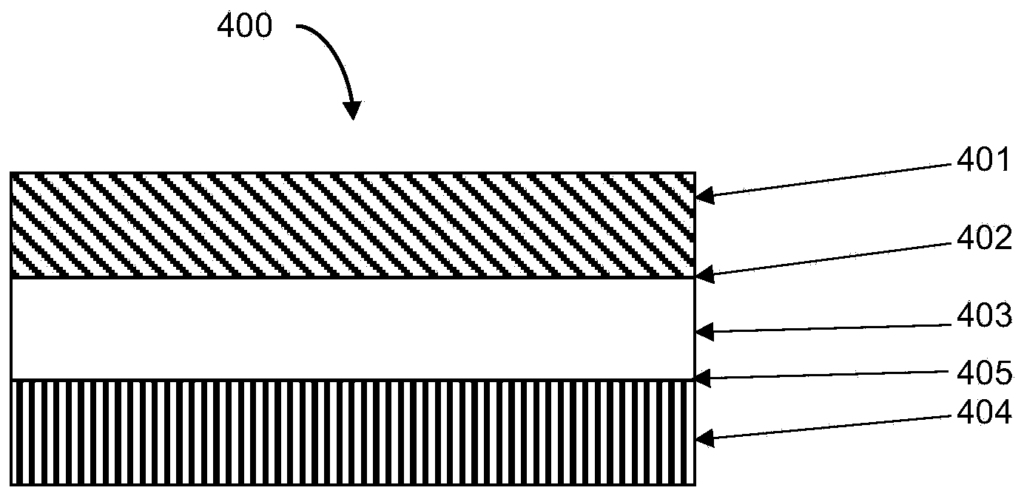
Click here to view the patent on Google Patents.
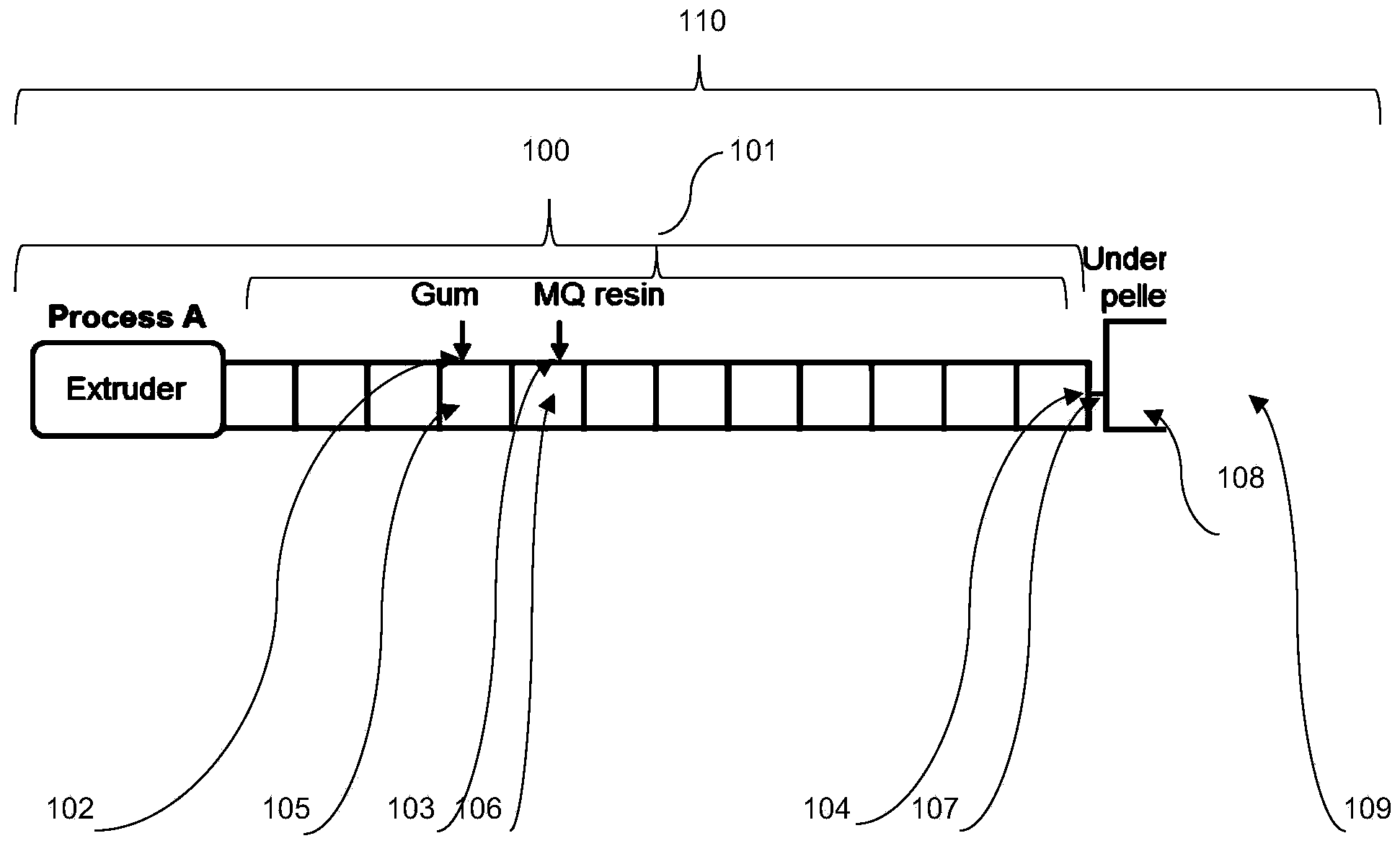
Leave a Reply